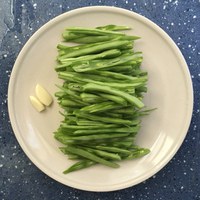Prairie Fare: Inspire Your Menus With Fresh Seasonal Vegetables
(Click an image below to view a high-resolution image that can be downloaded)
By Julie Garden-Robinson, Food and Nutrition Specialist
NDSU Extension
“I’ll have the garlic mashed potatoes and green beans as my two sides,” my younger daughter said.
We were celebrating her birthday. We were in a sit-down restaurant for the first time in months. We removed the required protective masks to eat, of course.
I glanced at her in disbelief. Since when does my “selective eater” choose green beans? And what’s up with ordering potatoes with garlic in them? This does not happen at home.
Who are you and what have you done with my daughter? I thought to myself.
Was my actual child abducted by space aliens and replaced by a vegetable-loving being?
Perhaps eating away from home made the difference. We had an adventure in social distancing with masked servers, closed nearby tables and booths, single-use condensed menus and divider circles on the floor for bill paying.
We had a delicious, memorable family meal.
We are reaching the point in the summer season when many vegetables, including green beans, are coming into season. We can buy them at a grocery store or farmers market, or pick them from our own garden. Encourage kids to help pick or select vegetables and help prepare them in the kitchen.
With my daughter’s menu selection, I am looking forward to providing her with hefty servings of green beans fresh from our backyard garden.
Green beans are a low-calorie, versatile food. They can be called “snap beans” because of the sound they make when they are broken in half. They also are called “string beans.”
One cup of fresh green beans has 31 calories, 0 grams (g) fat, 2 g protein, 7 g carbohydrate, 3 g fiber and 6 milligrams (mg) sodium. They also contain other nutrients, such as vitamins A, C and K, as well as folate and potassium.
My student interns helped create a pocket guide to preparing fruits and vegetables this spring, and it has proven to be popular. Here are a few tips about creative vegetable cookery from the guide, which might inspire your food preparation. Perhaps your family and friends will try fresh produce in new ways.
To view the complete colorful pocket guide, see https://tinyurl.com/NDSUPocketGuideVegetables for more ideas about preparing other fresh fruits and vegetables.
Bell peppers:
Fresh - Rinse and chop or julienne and enjoy. Great for topping a fresh salad or dipping in vegetable dip or hummus.
Saute - Cut peppers lengthwise into strips. Heat olive oil in a pan, then add peppers. Cook, stirring occasionally, until peppers are just tender, about 10 minutes.
Grill - Cut peppers lengthwise, brush with oil and place on a grill until grill marks appear (usually 10 to 14 minutes, depending upon desired tenderness).
Cucumbers:
Fresh - Rinse and chop cucumbers and enjoy fresh as a snack or mixed into a salad.
Smoothie - Rinse and chop cucumbers and add them to your favorite smoothie, then blend.
Spread - Rinse and finely chop cucumbers. Mix with cream cheese and seasonings to make a simple spread or add them to your favorite sandwich spread such as egg or chicken salad.
Leafy greens:
Fresh - Enjoy a variety of leafy greens as the base of a salad or blended into a smoothie.
Soups - Depending on the type of soup, try adding some spinach, Swiss chard, kale or collard greens.
Saute - Rinse leafy greens such as kale, Swiss chard or spinach, then saute in a pan with oil and seasonings of your choice.
Chips - Try turning kale into delicious kale chips. Rinse kale and mix with olive oil, salt and pepper. Spread on a baking sheet and bake in the oven at 325 F for 10 to 15 minutes, until they are crunchy.
Sweet corn:
Boil - Husk the corn and place in a pot of boiling water. Bring water back to a boil and let cook for five to seven minutes.
Grill - Lightly oil the corn and season as desired. Place corn on the grill and cook for about 10 minutes, rotating often until evenly charred.
Tomatoes:
Fresh - Enjoy tomatoes fresh on hamburgers, on a salad or in fresh salsa.
Roast - Halve or quarter the tomatoes and toss with olive oil and any desired seasoning such as basil, rosemary or thyme. Roast on a baking sheet lined with aluminum foil at 400 F for 30 minutes or until soft.
Stew - Place whole tomatoes in boiling water for one minute; immediately transfer to cold water so you can peel the skin easily. Cut the tomatoes into quarters and place in a large saucepan with salt. Simmer for 20 to 30 minutes, stirring occasionally.
See https://www.ag.ndsu.edu/fieldtofork for more information about growing to preserving fruits and vegetables.
Here’s a tasty way to enjoy fresh green beans.
Green Bean Saute
1 1/2 Tbsp. olive oil or your favorite cooking oil
2 cloves garlic, minced fine
3/4 pound fresh green beans, rinsed and ends trimmed
1/2 tsp. onion powder
1/2 tsp. seasoned salt or garlic salt (or your favorite seasoning salt)
Black pepper (to taste)
Heat oil in pan and briefly saute garlic. (Garlic burns easily.) Add remaining ingredients and stir fry until you reach the desired tenderness (about five to 10 minutes).
Makes four servings. Each serving has 70 calories, 5 g fat, 2 g protein, 7 g carbohydrate, 2 g fiber and 180 mg sodium.
(Julie Garden-Robinson, Ph.D., R.D., L.R.D., is a North Dakota State University Extension food and nutrition specialist and professor in the Department of Health, Nutrition and Exercise Sciences. Follow her on Twitter @jgardenrobinson)
NDSU Agriculture Communication - July 23, 2020
| Source: | Julie Garden-Robinson, 701-231-7187, julie.garden-robinson@ndsu.edu |
|---|---|
| Editor: | Ellen Crawford, 701-231-5391, ellen.crawford@ndsu.edu |




